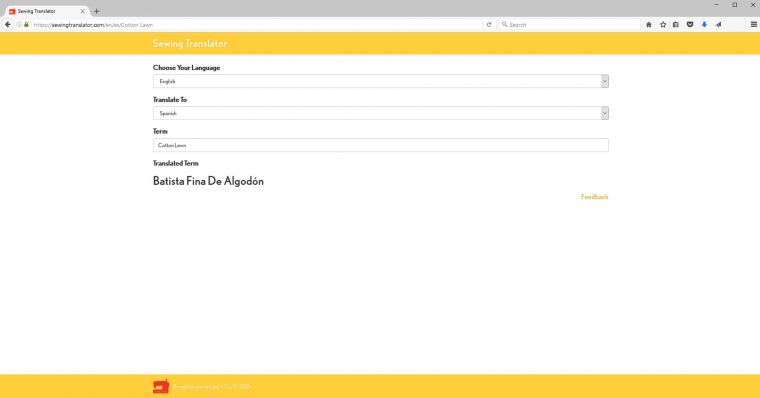Hey friends!
One of the things that I’ve noticed about living in a new country is how difficult it is to read non-standard, or technical, terminology. For example, it’s nearly impossible for me to read a Spanish menu because there are so many words that don’t translate directly. My standby translation tools, Google Translate and Word Reference, choke when presented with some of the interesting things listed on the menú del día at the restaurant on our street. (No, the pun wasn’t intended, but now that I’ve noticed it I’m going to leave it in because it’s very appropriate!)
This applies to sewing, too. Feed dogs are not quite the same in French (nourrir chiens?) and Spanish (alimenta perros?), so if you are trying to read a sewing pattern or shop for fabric and notions while on vacation, it gets really difficult.
I mentioned this challenge to Todd a while ago and told him how nice it would be to have something that would reliably translate sewing terms. He and our developer Justin have spent a little time working on this idea to help me–and all of you–out. But they didn’t do it alone because between the two of them they speak a grand total of 1.75 languages (including English!). But more on that in a minute.
I’m pleased today to be able to introduce you to Sewing Translator. You can check it out for yourself at sewingtranslator.com.
Sewing Translator uses a custom dictionary of sewing-related terminology that includes fabric types, garment types, tools, notions, machine parts, etc. It allows you to translate those terms between any of 10 languages. It’s a very simple translator, but it does the one thing it’s supposed to do quite well!
What we have released here is a very first, extremely basic version of something we would like to continue to expand and develop. Right now it functions in a web browser and requires internet connectivity. It’s fully optimized so it works like a dream on your phone, tablet, or computer. In the future, we would like to turn it into, as well, stand-alone native iOS and Android apps that do not require connectivity to work. If we see that people are making use of Sewing Translator, we will continue to develop and expand it.
As I alluded to earlier, we could never have assembled all these sewing terms in all these languages if it were not for the help of the members of the global Oliver + S community. Many people, when asked, pitched in and provided translations for the languages they speak. And for that, we owe a big “thank you” to all our contributors: An, Ana Sofia, Annika, Eva, Evgenia, Gioia, Giulia, Ines, Juliette, Laura, Maria, Maria, Marta, Miren, Monica, Silvia, Susanne, Valentina, and Yuki. (Can you guess which languages each provided by her name?)
We would love to hear what you think of Sewing Translator. You can provide feedback by using the Feedback link on the site. And if you speak a language we haven’t yet included and would be willing to help us add it, please let us know! We would love to add more languages to the mix.
Update (10/12/2016): We have had several people provide feedback already about how the user interface works well for shopping in a foreign country but not so well for getting help with sewing from a pattern written in another language. To be honest, that wasn’t a use case we had in mind when we were developing Sewing Translator. But it makes perfect sense to use it that way, and now that we think about it, Sewing Translator will probably get used in this way more often! So we’ve bumped to the top of our list some changes to the user interface that will make it easier to use when you are sewing from a foreign language pattern. We hope to have the new version ready to release soon. Thank you for that feedback–and for all the rest!

